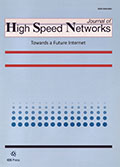Authors: Li, Victor O. K. | Willner, Alan E. | Dapkus, P. Daniel | Lee, Kuo-Chun | Norte, A. David | Park, Eugene | Shieh, William | Mathur, Atul
Article Type:
Research Article
Abstract:
This paper summarizes a proposal of research on all-optical networks submitted to the U.S. National Science Foundation in 1993. The objective is to explore the possible architectures, routing protocols, and system and device implementations for the metropolitan-area or wide-area wavelength-division-multiplexing (WDM) all-optical networks. The basic idea is to dramatically enhance the efficiency and throughput of such a WDM all-optical network by using wavelength conversion (or wavelength shifting) and by developing unique wavelength routing schemes which consider new models and requirements of all-optical networks. We will be conducting research on the intertwined networks, systems, and devices areas of photonics. In network
…research, new network architectures and routing algorithms will be designed to incorporate wavelength conversions which allow messages to shift wavelengths. Also, rerouting algorithms will be developed to rearrange the routes of certain existing circuits to accommodate more connections. Furthermore, the use of erbium-doped fiber amplifiers (EDFAs) in WDM networks will be considered, and routing algorithms will be designed to reduce the performance degradation due to the spectral gain nonuniformity or the bandwidth limitation of EDFAs. In systems research, an experimental WDM node will be built to incorporate many aspects of the above network and routing schemes and to show what limitations exist in these systems. Both commercially available and unique novel state-of-the-art devices (to be fabricated ourselves) will be employed for the systems experiments. In device research, a novel integrated wavelength converter will be fabricated to shift one wavelength to several other possible wavelengths. This integrated photonic device will include a semiconductor amplifier where the conversion takes place, and a multiple-wavelength laser array which will provide the necessary reference wavelengths. Such a photonic integrated circuit device will significantly aid in the practical implementation of wavelength shifting at a WDM node.
Show more
Keywords: All-Optical Networks, WDM Networks, Wavelength Routing, Wavelength Conversion, Optical Amplifiers, Optical Switching
DOI: 10.3233/JHS-1995-4102
Citation: Journal of High Speed Networks,
vol. 4, no. 1, pp. 5-25, 1995
Price: EUR 27.50





